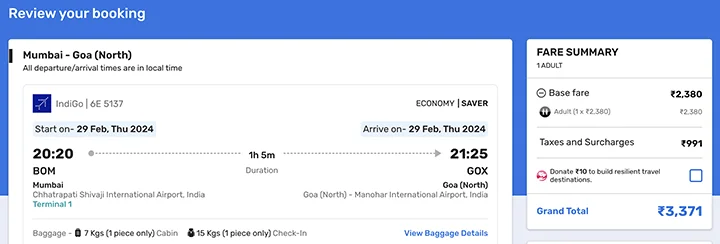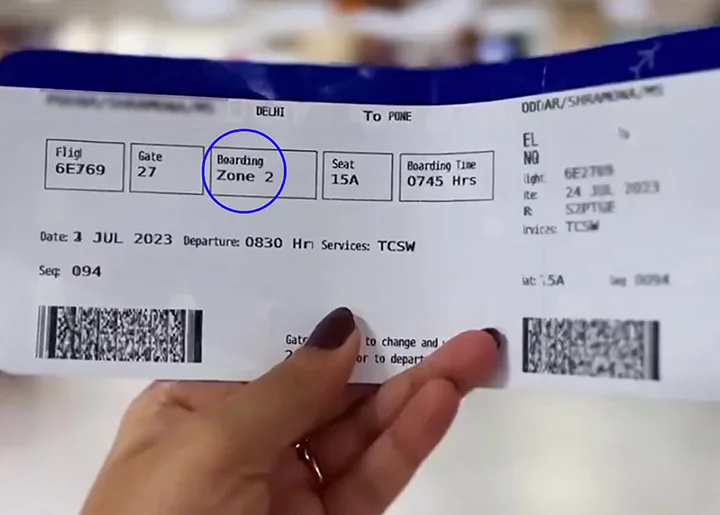Airborne AgoniesA UX designer’s review of air travel
Vysali Somanchi /
Flying can be quite an overwhelming experience and every aspect of the journey, can be exhausting. Right from booking the ticket, to collecting your luggage from the conveyor belt, we are all waiting to get far far away from an airport. As someone who travels frequently, I’ve noticed that the flying process often feels intentionally complex.
Why don’t we take a trip together & figure out what makes flying such a daunting experience.
Step 1: Book a flight ticket
There are multiple platforms with all kinds of interfaces, some clean, some not & more. But let’s talk about the whole gamble of the fluctuating prices. Shouldn’t this process be as straightforward as shopping? Instead, it often resembles the dynamic nature of the stock market with rapid fluctuations that evokes a sense of anxiety in us. Even after making a purchase, I wonder if I should have waited longer or acted sooner to get the best price.
So why can’t there be a fixed price! While it’s understandable to have seasonal variations, the daily and hourly changes in ticket prices can be frustrating. My problem is not with how expensive it is but with how & why it’s changing. Rapid and unpredictable changes can lead to user frustration, eroding confidence and loyalty. Implementing transparent communication about pricing adjustments, offering consistency where possible, and providing clear justifications for changes can mitigate demotivation and contribute to a more positive overall user experience. And may be don’t change prices in the blink of an eye. Tell users why the prices are changing hourly. Let users know when their trip’s price is at the ideal price point that they want to buy it at like Google flights does it.
Take a look at the price comparison of flight from Mumbai to Goa for 29th February over the course of 4 to 5 days consecutively.

Ticket checked on 15th Feb

Ticket checked on 16th Feb

Ticket checked on 17th Feb

Ticket checked on 18th Feb
This significant jump of almost Rs. 1000 in just three days for a flight from Mumbai to Goa further talks about the need for a more transparent and user-friendly pricing system. Such drastic fluctuations within a short timeframe intensify the frustration and confusion experienced by travellers.
Also, what’s up with all the hidden charges by the time you get to the payment gateway. Just show me a price that includes all kinds of charges & taxes. I pick a ticket that says Rs.2900 but on the payment gateway I am supposed to pay Rs. 3600?! Don’t do that. It’s extremely frustrating for the User.

Before entering the payment gateway, the “grand total” is Rs. 3371 including some taxes & surcharges.

After entering the payment gateway, the “grand total” is now Rs. 3680 with a convenience fee.
Step 2: Web check-in
This is a relatively straightforward task for tech-savvy individuals, but it’s worth considering various users’ technological comfort levels. There are situations where I have selected a seat for myself in this process. But when I go to the luggage check in counter & I am handed over the boarding pass, a completely different seat number has been printed on it. What’s the point of making me select my seat if I can’t be given what I am promised. I also noticed that some airlines force this step on you, but there are no free seats available. I don’t want to pay for a seat if I have already paid so much for the ticket. Upon multiple clicks or scrolls on that page, a ‘auto-assign seat for me’ button magically appears from nowhere. Some of these steps definitely feel like a hassle & put the user in a doubt whether the task at hand has been completed.
Step 3: Checking in luggage
Obviously, this is an optional step, only for those passengers that have luggage to check in. Unfortunately, I am not a light packer, so I have to deal with long queues & people cutting lines. I am always checking the flight’s status online before I leave for the airport & also on Flight info display system at the airport. So, I make sure to enquire about the flight’s status even at the luggage check in counter. There have been times where I have been told that the flight has been delayed by 3 hours. Why can’t you tell me that before I came to the airport? Clearly, that information is available to the airline employees. No one likes spending countless hours at an airport. Inadequate communication during flight delays kills passenger’s trust in the airline. It negatively impacts their perception of the airline’s reliability and customer service.
Step 4: Security
I dread this step the most. Once again, the long queues, cutting lines, passengers not knowing how to pass through this & so much more. For first time flyers, children & older passengers, this step is always a big question. They need guidance on what is supposed to happen in this step. Unloading all their luggage on those trays, removing the digital products, shoes & jackets for some, boarding pass with the passenger or in the tray, how much liquid to carry, there is scope for a lot of information to be given to the passengers at this point. These confused passengers could unknowingly & unwillingly cause delay & chaos for other passengers as well. But obviously, this is not the passengers’ fault. Airports need to come up with a better way to guide passengers through this step. Communication is again the key for ensuring a smooth process at the security as well. A combination of clear signage, video demonstrations & multilingual communication could help in guiding passengers through security without causing any delay or chaos for themselves & everyone else. Why not make dedicated queues for first timers or the passengers that seem lost in this step. This queue could be slower, have more guidance or help for these passengers. This way, the rest of the queues could be more efficient.
Step 5: On to the Boarding gates
Let’s head to our boarding gates now. Finding them usually isn’t so hard. The signage to these gates is loud, clear & everywhere making it difficult to miss them. But there is a possibility of boarding gate changes. The manner in which different airports manage these changes varies considerably. Some use public announcements over the intercom, others update the information display systems, certain airlines opt for text messages (I once even received a gate change message after landing), while some do not communicate changes at all. It’s evident that there is a significant lack of consistency in handling this situation.
One other thing I have noticed is that there’s usually a boarding time printed on our boarding passes but how many times have we boarded a flight at the time that we are supposed to? If you communicate something, you must also follow it through. Now, that printed boarding time means nothing to me. More chaos is caused when it’s actually time to board. The boarding agents announce the passengers to board zone wise. In most cases they are not audible & as it is the passengers crowd their desk as soon as the boarding announcement is made. Talking about the zone announcements, how many passengers are aware of a zone number being mentioned on their boarding pass? Let’s say quite a few are aware of its existence on the boarding pass, but how many people know the purpose of these zones? When I spotted a “Zone 1” mentioned on my boarding pass for the first time, I expected to be boarded inside first. But then I was called in last. Only when we boarded was when I realised what the whole deal with zones was. But most people still don’t understand this. And it also makes me wonder, would passengers still board as per zones if they understood what the purpose was. Overtime I also realised that zone wise boarding doesn’t just help in boarding faster but also lets me stow my luggage in the overhead cabins right above me. When it’s time to de-board the flight, I don’t have to go ahead or behind my seat to get my luggage. So, boarding a plane zone wise, has its own advantages. Maybe we should communicate that to the passengers. Specially a selfish motive of luggage stowing could motivate the passengers to follow this process. Users are more likely to follow a process if it offers added benefits or advantages to them. Also, incentivising users for good behaviour is a common and effective strategy to encourage desired actions and engagement.

Step 6: Flying
Once we board, the in-flight experience can be challenging due to claustrophobia, loud passengers, crying babies, seat kicking children, drunk & inappropriate passengers. Overall, the user experience of flying seems to be completely overlooked & needs a lot of rework.
Step 7: Landing & Deboarding
Once we land, along with many announcements from the captain & the flight attendant, which are mostly inaudible, they also announce the baggage conveyor belt number. When you reach that certain conveyor belt there are chances that you find out that the number had been changed & your luggage is sent through another belt. There are certain troubles that a passenger could face with this step. One, could be endless waiting for your luggage. I am one of those passengers whose luggage always seems to arrive last. Two, is the fear that your luggage will be misunderstood as their own by other passengers & be taken away. While I wait at the belt, I always jump to conclusions, imagine scenarios of how I can track & retrieve my bag from someone else if it does get taken away. Several strategies can be implemented to ensure that the passengers pick up their own luggage instead of others.
- Encourage passengers to use distinctive bag tags.
- Explore the possibility of integrating digital tracking solutions.
- Implement a system where airport staff occasionally check bags with passengers to ensure that they are retrieving the correct luggage.
- Provide QR codes upon check-in. Passengers can use these to match and verify their bags at the baggage claim.
By prioritizing customer satisfaction and streamlining the entire journey, Aviation systems and airlines can create an environment where passengers feel not just transported but cared for throughout the flying experience.
So there is a considerable opportunity for improvement in making flying a more enjoyable experience by incorporating user-centric principles. Here are some ways to go about it:
- Effective Communication
Establishing trust with users begins with open & clear communication. Communicate everything with passengers. More than once if necessary. - Transparency as a priority:
Transparency helps in fostering a positive relationship with passengers. Be upfront about pricing adjustments, policy changes, aircraft updates & any other pertinent information. - Consistency in Service delivery
Maintain consistency in service processes to provide passengers with a reliable & predictable travel experience. Whether it’s the check-in procedures, onboard services, or baggage handling, maintaining uniformity instils confidence in passengers and ensures a smoother and more enjoyable journey. - Empathy & Personalization
Demonstrate empathy towards passengers by recognizing and addressing their individual needs. Personalize services where possible, making passengers feel like more than just ticket holders. Acknowledging the unique aspects of each passenger’s journey contributes to a more positive and memorable flying experience.
In conclusion, the aviation industry can transform flying into a more enjoyable and customer-centric experience. Embracing these principles will not only enhance passenger satisfaction but also build lasting trust and loyalty.





